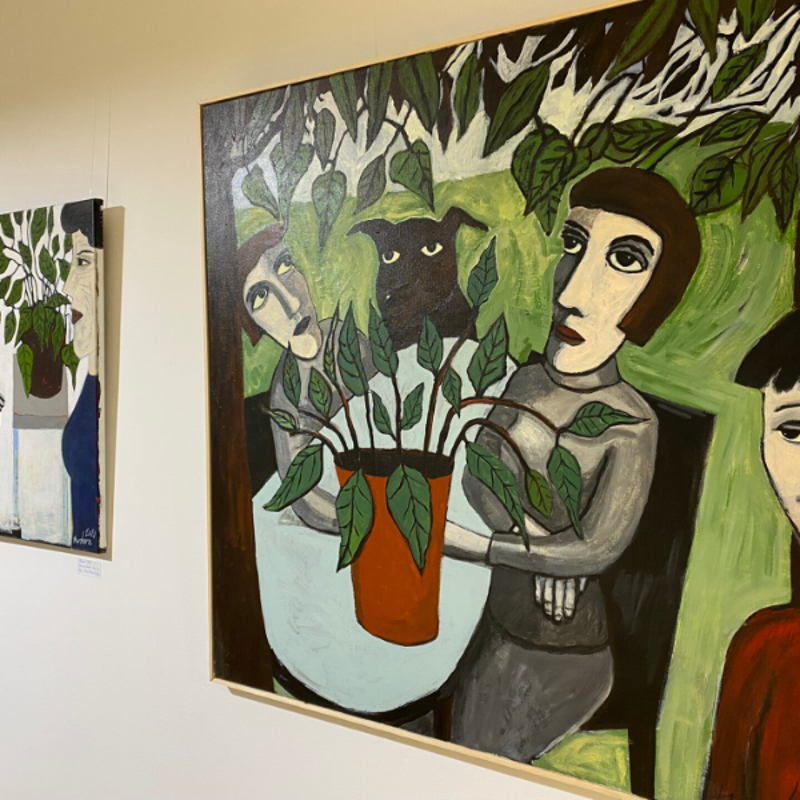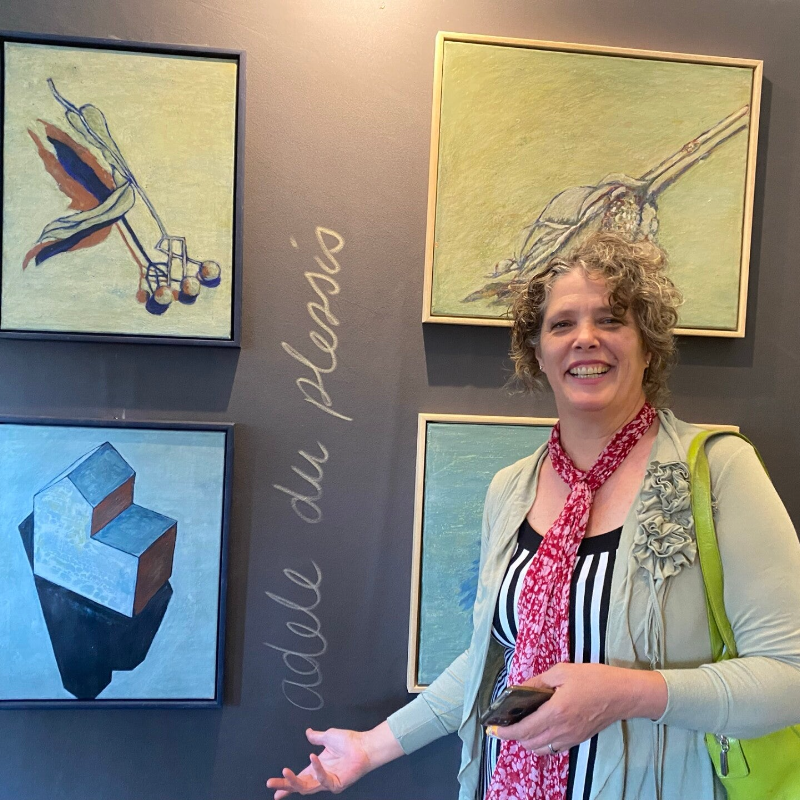
Art Historian Tascha Sciarone standing in front of artwork by Marko Klomp at DAF Frankfurt 2022. Contemplating the art. To the right is two sold pieces by artist Negar Rashidi
What should I do if I cannot afford buying art?
This is a question that is never stated outright to us at the gallery. It usually takes the form of people who have suddenly fallen in love with an artwork but has never had this transcendent experience of being moved by art. Especially not while they were on an errand to pick up cheese for their Saturday brunch and walked past something in the gallery. When they do come in, or if they saw it on Instagram and reach out, usually they are shocked at the price and apologise for not knowing anything about art. Or sometimes they will tell me it's not worth that amount and quote a price of €60,00 (which is an oddly specific amount I hear the most). The first few years this reaction struck me as odd. But over the years it has become evident there is a nervousness. I have had many people ramble through their thoughts over the years. Distilling those talks comes down to access to art and echoes of previous centuries of elitism and classicism.

Art Historian Tascha Sciarone with an artwork by Thea van Doorn. Artwork is art of the decade long series "Vrouw en Hond".
You are allowed to enjoy art
This article is just another way you can enjoy art, especially collectors or people who do not come from families with artists or art minded. If your only access to art was at school and on school trips. You might feel at a disadvantage when you love art but do not know if you are allowed to enjoy the art they way you have or looking for a guide on how to dip your toes into the art world, without having to buy art. This is not a guide for people that are artists, or people from families that had the privilege to impart them with museum and art interests. This is for people who would like to start their journey into enjoying art in their adult years. Maybe you have already started, and you want to check-in. This is very normal if you are aware of the echoing class division of previous centuries still informing our society on who gets to enjoy art.
Elitism and the arts
There has been a lot of literature written about the social, economic and cultural walls between people and Art. The literal buildings where most museums are housed are built to be imposing and only allow the "worthy" to have the balls to enter. We no longer think like this or create art and museum programmes like this, but most cultural institutions are still held in buildings when this was built into the architecture. A lot of academic literature (from the early 19th century) also explores how wealthy people usually introduce their children to cultural institutions from a young age and they simply grow up entering these spaces. That was why art programmes in schools exist so that everyone has access to these institutions and cultural objects. Because it's for all of us.
Now the prices of art in art galleries might also impose this same feeling of imposter syndrome in some people. Like they are not "allowed" to enter these spaces. And to be honest, it can be part of the gallery's marketing to create a space that is hostile to those who do not speak "the language" of art. Thereby making people who are attracted to elitism and do speak the language more inclined to buy at that gallery. This environment and language are not overt, it is more like historical signifiers inherent in museum architecture, they impose structure, price and colour in a way that it might dissuade people who already feel they are 'not allowed' from entering. Those are long-ingrained class echoes from previous centuries. But here you are, knowing that these echoes don't hold power, but still looking for tangible ways in which you can enjoy art on a budget, without buying art.

5 ways to enjoy all art has to offer in a budget
If you cannot afford to buy art, there are still many ways to enjoy and appreciate it. Here are a few suggestions.
1. Visit Museums and Galleries
Museums and galleries offer opportunities to view a wide range of art, from contemporary works to historic masterpieces. Many museums also offer free admission days or reduced prices for students and seniors. Art Galleries are usually free to enter and are happy to answer your questions. From my experience, most people visit galleries on Saturdays between 14:00-15:00 so if you want to avoid a crowd, go before then.
Gallery Sorelle Sciarone on the Lange Tiende weg in Gouda December 2021. The Bride | Marko Klomp | Figurative Painting is in the left window of the gallery.
2. Attend Art Fairs and Festivals
Art fairs and festivals provide opportunities to see and interact with a variety of artists and their work. These events often feature affordable pieces that are accessible to a wider range of budgets.
Pro-tip, email a gallery for free entrance tickets. Do not do it on the day of or the night before. The gallerist is very busy and works 16-hour days, which usually start 4 days before the art fair actually opens. Email a week or two ahead. We usually get 150 free tickets to share with our client base. But depending on the location we might only use 30 of those tickets for actual clients and are happy to leave one at the door for you. You can also ask galleries at the art fair if you can have an extra ticket if you want to come back on another day or with someone.
Gallery Sorelle Sciarone at Art Laren in 2022 with artwork by (L-R) Marko Klomp and Negar Rashidi. Art Laren is an accessible small art fair hosted by the local Kiwanis social club to raise money for diverse non-profits around the world.
3. Explore Public Art
Many cities and towns have public art installations that are free to view and enjoy. This could include sculptures, murals, or other works of art that are displayed in public spaces. The newest one here now in The Netherlands is the exciting "Moments Contained" by Thomas J Price in Rotterdam that was unveiled last week (3 June 2023). Here is a Dutch article Heldinnen van het gewone leven verdienen juist een standbeeld by Roline Redmond, legendary cultural anthropologist and writer.
A town will usually have a little map with all their public art in a route. If it is a vibrant art city like Rotterdam, these maps might be subdivided by art style (murals, poems, sculpture etc.).
In many big cities there might even be tour guides that live off of tips given after the tour. Usually they leave at set times from hotels or hostels and tourist usually indulge in these tours. However, there is nothing stopping you from attending this tour if you are from that place.

Artist Adéle du Plessis in front of her egg tempera pieces from her Drawn at Home series.
4. Support emerging artists
You can support emerging artists by attending their shows, following them on social media, and sharing their work with others. This can help artists gain exposure and build their careers. This takes time and dedication to do this. Read this article if you are interested in how you are intricate to the art eco system with your support int his article: How to understand contemporary art. If you are starting on your art collector journey this is also where you will find art for the smallest of budgets.

A small 10cm x 10cm painting by an emerging artist at the gallery, artwork is still under €100,00.
5. Create your own art
Making your own art is a great way to engage with the creative process and express yourself. You don't need expensive materials or formal training to create something beautiful and meaningful. It might not be good, yet. I have good and bad art in my home, by amateurs, professionals, unknown thrift shop finds and works by my children. I am a classically trained Art Historian and many of these works are simply valuable to me or my loved ones. Also in making art you can appreciate art better. You know how much effort, time and skill goes into artwork, when you yourself have dabbled in different techniques and materials. You also know the costs of material and time. It makes you appreciate art in a different way. I for one love a seascape, largely because I admire those who can paint it. I find seascapes one of the most difficult things to paint to the standard I expect. Which exponent increases my awe of an artwork that do meet those standards.
Fiona J. Williams spectacular portrait I'll think over it. Putting you in the mood for contemplation.
In Conclusion
Remember, enjoying and appreciating art doesn't have to be an expensive endeavor. By seeking out free or low-cost opportunities to view and engage with art, you can still experience the many benefits that art has to offer. Yes, the prices at the gallery are steep, for some people steep begins at over €100,00 and for others over €10.000,00. What we are offering is art and education to all. That we don't get funding for, but do it because we love art and sharing it with people. Being open and free to the public, is supported by buying the art. You get to set the limits how you consume art. Go forth and be free.
Lots of Love,
Tascha Sciarone
Art Historian
We recommend the following article,
and scroll down to the third part, which also
outlines how these steps above is also an
investment in yourself.





Add comment
Comments